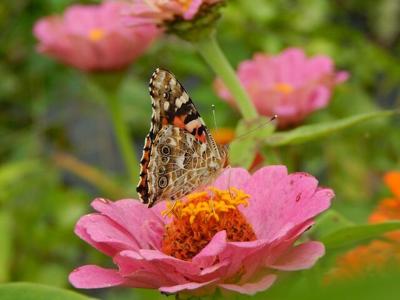
Gardening is a form of art that allows one to connect with nature and create their own outdoor haven. Whether it be a small patio container garden or a large estate, the beauty of nature can be incorporated in various ways.
This guide aims to provide a comprehensive understanding of the different garden types, including their unique characteristics and design elements, allowing garden enthusiasts to explore the beauty of nature and create their own personalized garden oasis.
From traditional English gardens to modern Zen gardens, this guide will delve into the rich diversity of gardening styles, providing inspiration and practical tips for creating a beautiful and sustainable outdoor space.
English Gardens
English Gardens is one the traditional types of garden design that originated in England during the 17th century and have since become popular around the world. These gardens are characterized by their elegant and naturalistic appearance, incorporating features such as lawns, shrubs, trees, flowers, and water features.
They often feature winding paths and secluded seating areas, providing a peaceful retreat from the hustle and bustle of everyday life. English Gardens draw inspiration from the beauty of nature, with an emphasis on creating a harmonious and well-balanced landscape. They typically feature a mixture of annual and perennial plants, as well as a variety of trees and shrubs that provide year-round interest.
Some of the most popular plants used in English Gardens include roses, lavender, hydrangeas, and foxgloves. In addition to plants, many English Gardens also incorporate structures such as arbors, trellises, and gazebos that provide shade and visual interest. These gardens are a favorite among gardening gurus as these can be designed in a variety of styles, including cottage, formal, and woodland.
Regardless of the specific design, English Gardens are renowned for their beauty and ability to create a peaceful and relaxing atmosphere.
Butterfly Gardens
Butterfly Gardens are special types of gardens that are designed to attract and support different species of butterflies. These gardens typically feature plants that provide food and habitats for butterfly larvae and adult butterflies, such as host plants for larvae to lay their eggs on and nectar-rich flowers for adult butterflies to feed on.
Common host plants for butterfly larvae include milkweeds, fennel, and dill, while popular nectar plants include bee balm, butterfly bushes, and coneflowers. In addition to plants, Butterfly Gardens may also include features such as sun-catching rocks, puddling stations for male butterflies to obtain minerals, and shelter from the wind.
A well-designed Butterfly Garden can attract a variety of butterfly species and provide a peaceful and educational environment for visitors to observe and appreciate these fascinating creatures. By creating a habitat for butterflies, Butterfly Gardens also play an important role in supporting the overall health and diversity of local ecosystems.
Water Gardens
Water gardens, also known as aquatic gardens or pond gardens, are landscaped gardens that feature a body of water as their central focus. They often incorporate features such as waterfalls, fountains, fish ponds, and aquatic plants. Water gardens can range in size from small, contained water features to large, naturalistic ponds and lakes.
These gardens serve as a haven for wildlife and provide a peaceful, calming environment for their visitors. In addition to their aesthetic value, water gardens can also provide a source of irrigation and recreation, as well as serving as a habitat for fish and other aquatic creatures.
Whether a minimalist and modern or a traditional and naturalistic design, water gardens offer a unique and beautiful way to bring the calming element of water into a landscape.
Zen Gardens
Zen Gardens, also known as Japanese rock gardens or karesansui, are traditional gardens found in Japanese temples and private homes. These gardens are characterized by the use of rocks, gravel, sand, and moss, arranged in such a way as to suggest mountains, rivers, and other natural landscapes.
They are meant to be viewed while seated, and are often accompanied by a tea house where visitors can meditate and enjoy the serene atmosphere. Zen Gardens are not only aesthetically pleasing, but also serve as a symbol of simplicity, tranquility, and the quest for inner peace in Japanese culture.
In conclusion, gardening is a wonderful way to bring the beauty of nature into our lives. From the tranquility of Zen gardens to the serene beauty of water gardens, there are many different garden types to explore and enjoy. Each type of garden has its own unique characteristics and provides a different experience, whether it's a peaceful retreat, a place for recreation, or simply a beautiful view. Understanding these different garden types can help us make informed decisions about how we want to incorporate nature into our lives, and find the garden that is right for us. Whether you are a seasoned gardener or just starting out, there is something for everyone in the wonderful world of gardens.
Here are Some Other Articles Related to Your Search:
The Garden Helper's Calendar of Gardening Tasks and Projects




(0) comments
We welcome your comments
Log In
Post a comment as Guest
Keep it Clean. Please avoid obscene, vulgar, lewd, racist or sexually-oriented language.
PLEASE TURN OFF YOUR CAPS LOCK.
Don't Threaten. Threats of harming another person will not be tolerated.
Be Truthful. Don't knowingly lie about anyone or anything.
Be Nice. No racism, sexism or any sort of -ism that is degrading to another person.
Be Proactive. Use the 'Report' link on each comment to let us know of abusive posts.
Share with Us. We'd love to hear eyewitness accounts, the history behind an article.